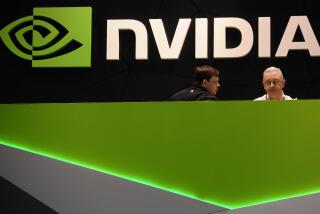THE TIMES 100 : The Best Performing Companies in California : THE FAST TRACK : Silicon Graphics Breaks Into the Open : The firm emerges as a key player in a consortium that aims to set standards for a new generation of powerful desktop computers.
- Share via
For most of its short history, Silicon Graphics has quietly gone about its business of making high-powered graphics computers, attracting little attention from anyone except film animators and product designers who used its machines and investors shrewd enough to have purchased its stock.
Founded in 1982 by a group of Stanford University professors and graduate students, Silicon Graphics has done well enough to achieve near-total domination of its cozy market segment and well enough to capture the No. 7 spot on this year’s Growth 100 list as compiled by MZ Group of San Francisco. The Mountain View firm ranked ninth last year.
But all that changed earlier this year when Silicon Graphics emerged as a key player in a consortium of big-name computer companies including Compaq, Digital Equipment and Microsoft. The 21-company initiative, called the Advanced Computing Environment, aims to set standards for a new generation of powerful desktop computers, and the involvement of Silicon Graphics indicates its intention to break out of its narrow market segment.
“This is a period of adolescence for our company,” says President and Chief Executive Edward R. McCracken, who joined the firm in 1984 after 16 years at Hewlett-Packard. “We’ve been known as a successful company, but a niche company, and now we’re growing into a mainstream company.”
That effort will get a big boost from Compaq, which agreed last month to pay $135 million for a 13% stake in Silicon Graphics and will also contribute $50 million in research and development funding.
Although analysts assumed that Compaq was mainly interested in Silicon Graphics’ proprietary three-dimensional graphics technology--some of which has also been licensed to International Business Machines and Microsoft--McCracken says the objectives are much broader.
He points out that Silicon Graphics was the first computer company to base its entire product line on a new design technique called reduced instruction set computing (RISC) and that it was the first to adopt a RISC-based computer-on-a-chip from Mips Computer Systems. That microprocessor, as such chips are called, is a key element of the ACE standard.
McCracken said Silicon Graphics would use its expertise in designing Mips-based systems to challenge Sun Microsystems, International Business Machines, Hewlett-Packard and others in building powerful “servers” that act as storage sites and traffic cops for networks of desktop computers.
“We were one of the first to develop symmetric multiprocessing (which uses more than one computer-on-a-chip simultaneously), and we’ve designed twice as many Mips machines as anyone else,” McCracken notes. “The technology is changing very rapidly in our market, and we thrive on change.”
“They have a really rich body of technology,” says Robert Herwick, an analyst at Hambrecht & Quist in San Francisco. “And their skill in implementing systems is what made them of so much interest to Compaq.”
But he cautions that as Silicon Graphics expands its focus, it will face much rougher competition from much larger companies, and thus its profits might come under pressure. The company posted revenue of $420 million and profit of $66 million in 1990, although results for the first quarter this year were below expectations.
Silicon Graphics hasn’t had to worry too much about competition because it was almost alone in offering relatively affordable “visual processing” machines that allowed a car designer, for example, to create a full-color, three-dimensional graphics model, and twist and turn it on the screen in real time. The machines, which cost $50,000 to $100,000, were also popular for film animation and for specialized defense-related work.
But during the past several years Silicon Graphics has offered less-expensive products to expand its base. McCracken acknowledges the dangers of moving even further into mainstream markets, where its graphics technology won’t give it such a big edge, but says the company has no choice.
“No matter what your niche, there’s no place to hide,” he says. “Our objective is to compete out there with anyone who wants to compete with us.”
FASTEST PROFIT GROWTH
Companies ranked by two-year average annual growth in profits.
2-year avg. 1990 1988 annual profit income income Rank Company growth % ($ millions) ($ millions) 1 Unocal Corp. 308.8 401.000 24.000 2 Pacific Gas & Electric 298.6 987.170 62.127 3 Conner Peripherals 156.5 130.052 19.768 4 Quantum Corp.* 127.4 66.659 12.887 5 Cadence Design Systems 70.2 38.007 13.116 6 Silicon Graphics Inc.* 62.6 32.261 12.206 7 Mattel Inc. 59.3 91.185 35.924 8 Fluor Corp.* 56.9 138.881 56.395 9 Mercury General Corp. 56.0 51.558 21.188 10 Union Bank 55.9 146.465 60.230 11 Everex Systems Inc.* 52.6 24.456 10.504 12 Anthem Electronics Inc. 43.3 23.210 11.309 13 Bergen Brunswig Corp.* 38.0 62.566 32.855 14 Adobe Systems Inc.* 37.9 40.070 21.080 15 Cubic Corp.* 37.2 23.032 12.228 16 Sumitomo 35.5 44.904 24.452 17 Farmer Bros Co. 32.7 19.812 11.249 18 Countrywide Credit Ind. 32.3 18.981 10.840 19 FHP International Corp.* 32.1 28.757 16.483 20 Acuson Corp. 31.9 47.836 27.493 21 Autodesk Inc.* 31.0 56.082 32.695 22 20th Century Industries 29.9 98.700 58.531 23 Sun Microsystems Inc.* 29.4 111.179 66.436 24 Gap Inc.* 28.3 122.247 74.231 25 BankAmerica Corp. 26.6 877.000 547.000
* See exceptions, page 55.
Source: MZ Group. Certain historical data is from Standard & Poor’s Compustat Inc.






